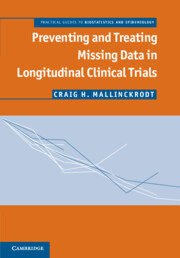Book contents
- Frontmatter
- Contents
- List of Figures
- List of Tables
- Acknowledgments
- Preface
- Part I Background and Setting
- Part II Preventing Missing Data
- Part III Analytic Considerations
- Part IV Analyses and The Analytic Road Map
- 9 Analyses of Incomplete Data
- 10 MNAR Analyses
- 11 Choosing Primary Estimands and Analyses
- 12 The Analytic Road Map
- 13 Analyzing Incomplete Categorical Data
- 14 Example
- 15 Putting Principles into Practice
- Bibliography
- Index
11 - Choosing Primary Estimands and Analyses
Published online by Cambridge University Press: 05 February 2013
- Frontmatter
- Contents
- List of Figures
- List of Tables
- Acknowledgments
- Preface
- Part I Background and Setting
- Part II Preventing Missing Data
- Part III Analytic Considerations
- Part IV Analyses and The Analytic Road Map
- 9 Analyses of Incomplete Data
- 10 MNAR Analyses
- 11 Choosing Primary Estimands and Analyses
- 12 The Analytic Road Map
- 13 Analyzing Incomplete Categorical Data
- 14 Example
- 15 Putting Principles into Practice
- Bibliography
- Index
Summary
Introduction
Previous chapters focused on estimands, methods of and models for estimation, and means for dealing with missing data. These topics are now considered jointly in order to appreciate the interactions between them. For example, different estimands applied to the same data may yield greater or fewer missing values, which can influence the method of estimation and the validity of assumptions.
In the following section, the six estimands introduced in Chapter 3 are discussed with regard to data choices, methods of estimation, and assumptions. To refocus the discussion, key attributes of the 6 estimands are summarized in Table 11.1.
Estimands, Estimators, and Choice of Data
Estimand 1
Difference in Outcome Improvement at the Planned Endpoint for all Randomized Subjects
Estimand 1 tests a de facto (effectiveness) hypothesis at the planned endpoint of the trial, based on all randomized patients. Data after discontinuation of the initially randomized study medication and/or initiation of rescue medication are included in the primary analysis. Given the confounding influences of the follow-up data, inferences are based on the treatment regimen, not the initially randomized treatments.
- Type
- Chapter
- Information
- Preventing and Treating Missing Data in Longitudinal Clinical TrialsA Practical Guide, pp. 103 - 110Publisher: Cambridge University PressPrint publication year: 2013



